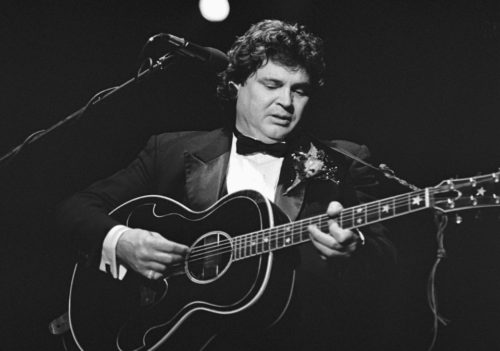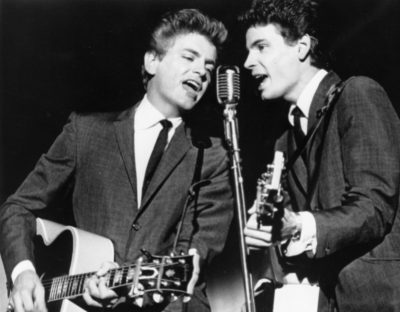
Don Everly of the Everly Brothers
By Michael Swanger
Former Iowan Don Everly, who alongside his younger brother, Phil, formed the Rock & Roll Hall of Fame duo the Everly Brothers, died on Saturday, Aug. 21, at his home in Nashville. He was 84.
According to the Los Angeles Times, “A statement from the family read in part: ‘Don lived by what he felt in his heart. Don expressed his appreciation for the ability to live his dreams … with his soulmate and wife, Adela, and sharing the music that made him an Everly Brother.’”
The Everly Brothers were renowned for their soaring harmonies and ground breaking sound that shaped early rock ‘n’ roll and country-rock music that influenced generations of musicians. In a five year span (1957-1962) they scored 15 top 10 hits. The Everly Brothers were among the first group of 10 artists to be inducted into the Rock & Roll Hall of Fame in 1986, alongside Elvis Presley, Chuck Berry, Little Richard, Buddy Holly and Jerry Lee Lewis.
Before the Everly Brothers became prodigious hit makers with songs like “Bye Bye Love,” “Wake Up Little Susie,” “All I Have To Do Is Dream,” “Cathy’s Clown” and “When Will I Be Loved,” they cut their teeth in the music business by playing with their family’s band during their childhood and teenage years in Shenandoah from 1945 to 1953.
In an interview with Iowa History Journal for a story that was published in our 2019 May/June issue to preview that year’s Everly Heritage Day — an annual festival to celebrate the Everly Brothers and Shenandoah’s contributions to early rock ‘n’ roll and radio — Bill Hillman, who organized the 1986 Everly Brothers homecoming concert, told IHJ, “The beginnings of rock ‘n’ roll started in Shenandoah.”
Hillman, 65, owns the Depot Deli and led the charge in 2005 to save and preserve the Everlys’ small childhood home which was originally located on 6th Avenue. In 2006, it was moved to 800 West Sheridan Ave., where it stands next to the Greater Shenandoah Historical Society Museum. Hillman said the Everly Brothers Childhood Home, which has been converted into a museum, and Everly Heritage Day festival tell entertaining and informative stories about the roots of rock ‘n’ roll. This year’s event will be held on Sept. 25 as the town also celebrates its sesquicentennial.
“Most people know that the Everly Brothers lived in Shenandoah, but don’t understand the importance of how they were among the originators of rock ‘n’ roll music and how they brought country music into rock ‘n’ roll,” he said. “They were part of the first class inducted into the Rock and Roll Hall of Fame and they got their start in Shenandoah because it was a place where musicians could get a full-time job playing music.”

Don and Phil Everly
The duo’s parents, Issac Milford “Ike” and Margaret Embry Everly, taught their sons to sing and play guitar at an early age. Ike, a coal miner from Kentucky, played music after work with his brothers and developed a thumb-picking guitar style that he later taught to country music’s Merle Travis. He became a full-time musician by the time Don — born Isaac Donald Everly on Feb. 1, 1937, in Brownie, Ky. — was two years old and the family moved to Chicago, Ill., so he could perform on radio. Phillip Everly was born there on Jan. 19, 1939.
In 1944, the Everly family moved to Waterloo where the two young brothers attended Longfellow Elementary School for a year before the family settled down in Shenandoah to accept a job offer at radio station KMA, founded in 1925 by seed salesman Earl May. The small southern Iowa town which became known in the 1920s as the “Seed and Nursery Capital of the World” is where the young Everlys learned to play a variety of musical styles and developed their live performances onstage and over the airwaves. By the time the boys were eight and six years old, respectively, “Little Donnie” and “Baby Boy Phil” were performing with their parents on KMA and KFNF, another local station founded in 1924 by May’s seed business rival Henry A. Field. Both radio stations offered farm news and live productions of hillbilly music that according to KMA’s website drew more than one million people to Shenandoah to see and hear musicians perform live on radio.
“Those two big radio stations were popular and they allowed musicians to try new things,” said Hillman, noting that KMA, KFNF and local music venues attracted hundreds of full-time musicians to the town of 5,000 people, including the likes of Bill Monroe, Lefty Frizzell and Riders of the Purple Sage. “It’s important that people know how popular those radio stations were in the U.S.”
By 1950, “The Everly Family Show” was a staple of live radio entertainment. The boys would perform daily at 6:30 a.m. before going to school. On weekends, they would travel to perform with their parents at dances and county fairs.
“In addition to their morning radio show they had a paper route and went to school and were into sports,” said Hillman. “They were always on the go. By the time they showed up to perform they were already stars because people heard them on the radio.”
Hillman said contrary to their popularity at a young age, “The Boys,” as they were called by the local townspeople, remained humble.
“They didn’t think they were different than anybody else, even when they wore their cowboy uniforms to school because they had a show afterwards,” he said. “They were part of the town’s tapestry. They were always polite and had a clean image, even as adults.”
In high school, the brothers played in their own combos and with their family’s band. But before they could finish high school, the Everly family accepted a radio job in the summer of 1952 in Evansville, Ind., and in September 1953 they moved to Knoxville, Tenn., to work for Cas Walker’s WROL radio show that paid $90 per week.
During the late 1950s through the early 1960s, the Everly Brothers rose to world-wide fame and critical acclaim on the strength of hit singles for Cadence and Warner Brothers Records that showcased their close vocal harmonies (Don sang baritone and Phil sang tenor), identifiable lyrics and distinct rock ’n’ roll sound inspired by pop and country. Their popularity also benefitted from their relentless touring and a television series for CBS. They would record a string of albums through the end of the 1960s until they ceased to be hitmakers and pursued solo careers.
Their career slowed by the mid-1960s due to their enlistment in the United States Marine Corps Reserve (which took them out of the spotlight), a dispute with Acuff-Rose Music (which lasted until 1964), health problems (including their addiction to amphetamines and Don’s nervous breakdown) and mounting tensions that infamously climaxed during a California concert in 1973 in which Phil smashed his guitar and walked off stage after Don had told a reporter he was tired of being an Everly Brother. The two would not reunite until a concert at Royal Albert Hall in London in 1983.
Their legacy is that of rock ’n’ roll royalty having released 35 Billboard Top 100 singles, 26 of which were in the top 40. They hold the record for the most Top 100 singles by any duo with only Hall & Oates having more Top 40 singles as a duo. Equally impressive is their far-ranging influence on groups like The Beatles, The Beach Boys, Simon & Garfunkel, The Bee Gees, The Hollies, Gram Parsons, Linda Ronstadt and The Milk Carton Kids, all of which developed their own styles by performing Everly Brothers songs and cite them as major influences. They received a Grammy Lifetime Achievement Award in 1997 and were inducted into the Country Music Hall of Fame in 2001, the same year that Rolling Stone called the Everly Brothers “the most important vocal duo in rock.” In 2003, they were inducted into the Iowa Rock ‘n’ Roll Hall of Fame.
Over the years, the Everly Brothers never forgot their Iowa roots, performing at venues like the Surf Ballroom, Roof Garden Ballroom and Clay County Fair. Their homecoming concert in Shenandoah on July 5, 1986, was the crown jewel of them all as it attracted fans from across the U.S. and CBS broadcast coverage of the event. Proceeds from the show were donated to the Everly Family Scholarship Fund which continues to fund scholarships to middle and high school students in Shenandoah. The homecoming festivities also included a parade, street dedication, class reunion and The Boys were given ceremonial keys to the city.
“They knew the reason they made it was because of what they learned here,” said Hillman, who worked closely with Phil Everly to organize the concert. “They really wanted to come back and perform.”
To read more of our story get a copy of our 2019 May/June issue.
(Michael Swanger is the owner and publisher of Iowa History Journal and a former longtime music critic for central Iowa newspapers.)
